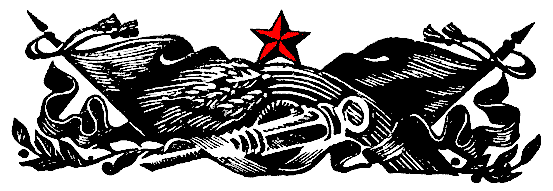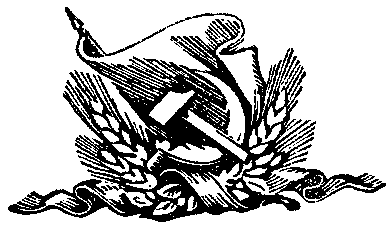
1936 CONSTITUTION OF THE USSR
Adopted December 1936
CHAPTER I

THE ORGANIZATION OF SOVIET SOCIETY

CHAPTER I

THE ORGANIZATION OF SOVIET SOCIETY
ARTICLE 1. The Union of Soviet Socialist Republics is a socialist state of workers and peasants.
ARTICLE 2. The Soviets of Working People's Deputies, which grew and attained strength as a result of the overthrow of the landlords and capitalists and the achievement of the dictatorship of the proletariat, constitute the political foundation of the U.S.S.R.
ARTICLE 3. In the U.S.S.R. all power belongs to the working people of town and country as represented by the Soviets of Working People's Deputies.
ARTICLE 4. The socialist system of economy and the socialist ownership of the means and instruments of production firmly established as a result of the abolition of the capitalist system of economy, the abrogation of private ownership of the means and instruments of production and the abolition of the exploitation of man by man, constitute' the economic foundation of the U.S.S.R.
ARTICLE 5. Socialist property in the U.S.S.R. exists either in the form of state property (the possession of the whole people), or in the form of cooperative and collective-farm property (property of a collective farm or property of a cooperative association).
ARTICLE 6. The land, its natural deposits, waters, forests, mills, factories, mines, rail, water and air transport, banks, post, telegraph and telephones, large state-organized agricultural enterprises (state farms, machine and tractor stations and the like) as well as municipal enterprises and the bulk of the dwelling houses in the cities and industrial localities, are state property, that is, belong to the whole people.
ARTICLE 7. Public enterprises in collective farms and cooperative organizations, with their livestock and implements, the products of the collective farms and cooperative organizations, as well as their common buildings, constitute the common socialist property of the collective farms and cooperative organizations. In addition to its basic income from the public collective-farm enterprise, every household in a collective farm has for its personal use a small plot of land attached to the dwelling and, as its personal property, a subsidiary establishment on the plot, a dwelling house, livestock, poultry and minor agricultural implements in accordance with the statutes of the agricultural artel.
ARTICLE 8. The land occupied by collective farms is secured to them for their use free of charge and for an unlimited time, that is, in perpetuity.
ARTICLE 9. Alongside the socialist system of economy, which is the predominant form of economy in the U.S.S.R., the law permits the small private economy of individual peasants and handicraftsman based on their personal labor and precluding the exploitation of the labor of others.
ARTICLE 10. The right of citizens to personal ownership of their incomes from work and of their savings, of their dwelling houses and subsidiary household economy, their household furniture and utensils and articles of personal use and convenience, as well as the right of inheritance of personal property of citizens, is protected by law.
ARTICLE 11. The economic life of the U.S.S.R. is determined and directed by the state national economic plan with the aim of increasing the public wealth, of steadily improving the material conditions of the working people and raising their cultural level, of consolidating the independence of the U.S.S.R. and strengthening its defensive capacity.
ARTICLE 12. In the U.S.S.R. work is a duty and a matter of honor for every able-bodied citizen, in accordance with the principle: "He who does not work, neither shall he eat."

ARTICLE 13. The Union of Soviet Socialist Republics is a federal state, formed on the basis of the voluntary association of Soviet Socialist Republics having equal rights, namely:
The Russian Soviet Federated Socialist Republic
The Ukrainian Soviet Socialist Republic
The Byelorussian Soviet Socialist Republic
The Azerbaidjan Soviet Socialist Republic
The Georgian Soviet Socialist Republic
The Armenian Soviet Socialist Republic
The Turkmen Soviet Socialist Republic
The Uzbek Soviet Socialist Republic
The Tadjik Soviet Socialist Republic
The Kazakh Soviet Socialist Republic
The Kirghiz Soviet Socialist Republic
The Karelo-Finnish Soviet Socialist Republic
The Moldavian Soviet Socialist Republic
The Lithuanian Soviet Socialist Republic
The Latvian Soviet Socialist Republic
The Estonian Soviet Socialist Republic.
ARTICLE 14. The jurisdiction of the Union of Soviet Socialist Republics, as represented by its highest organs of state authority and organs of government, covers:
ARTICLE 15. The sovereignty of the Union Republics is limited only within the provisions set forth in Article 14 of the Constitution of the U.S.S.R. Outside of these provisions, each Union Republic exercises state authority independently. The U.S.S.R. protects the sovereign rights of the Union Republics.
ARTICLE 16. Each Union Republic has its own Constitution, which takes account of the specific features of the Republic and is drawn up in full conformity with the Constitution of the U.S.S.R.
ARTICLE 17. To every Union Republic is reserved the right freely to secede from the U.S.S.R.
ARTICLE 18. The territory of a Union Republic may not be altered without its consent.
ARTICLE 19. The laws of the U.S.S.R. have the same force within the territory of every Union Republic.
ARTICLE 20. In the event of a discrepancy between a law of a Union RepubliL and an all-Union law, the all-Union law prevails.
ARTICLE 21. A single Union citizenship is established for all citizens of the U.S.S.R.
ARTICLE 22. The Russian Soviet Federated Socialist Republic consists of the Altai, Krasnodar, Krasnoyarsk, Ordjonikidze, Maritime and Khabarovsk Territories; the Archangel, Vologda, Voronezh, Gorky, Ivanovo, Irkutsk, Kalinin, Kirov, Kuibyshev, Kursk, Leningrad, Molotov, Moscow, Murmansk, Novosibirsk, Omsk, Orel, Penza, Rostov, Ryazan, Saratov, Sverdlovsk, Smolensk, Stalingrad, Tambov, Tula, Chelyabinsk, Chita, Chkalov and Yaroslavl Regions; The Tatar, Bashkir, Daghestan, Buryat-Mongolian, Kabardino-Balkarian, Kalmyk, Komi, Crimean, Mari, Mordovian, Volga German, North Ossetian, Udmurt, Checheno-Ingush, Chuvash and Yakut Autonomous Soviet Socialist Republics; and the Adygei, Jewish, Karachai, Oirot, Khakass and Cherkess Autonomous Regions.
ARTICLE 23. The Ukrainian Soviet Socialist Republic consists of the Vinnitsa, Volynsk, Voroshilovgrad, Dnepropetrovsk, Drogobych, Zhitomir, Zaporozhe, Izmail, Kamenets-Podolsk, Kiev, Kirovograd, Lvov, Nikolaev, Odessa, Poltava, Rovno, Stalino, Stanislav, Sumy, Tarnopol, Kharkov, Chemigov and Chernovitsy Regions.
ARTICLE 24. The Azerbaidian Soviet Socialist Republic includes the, Nakhichevan Autonomous Soviet Socialist Republic and the Nagorno-Karabakh Autonomous Region.
ARTICLE 25. The Georgian Soviet Socialist Republic includes the Abkhazian Autonomous Soviet Socialist Republic, the Adjar Autonomous Soviet Socialist Republic and the South Ossetian Autonomous Region.
ARTICLE 26. The Uzbek Soviet Socialist Republic consists of the Bukhara, Samarkand, Tashkent, Ferghana, and Khorezm Regions, and the Kara-Kalpak Autonomous Soviet Socialist Republic.
ARTICLE 27. The Tadjik Soviet Socialist Republic consists of the Garm, Kuliab, Leninabad and Stalinabad Regions, and the Gomo-Badakhshan Autonomous Region.
ARTICLE 28. The Kazakh Soviet Socialist Republic consists of the Akmolinsk, Aktyubinsk, Alma-Ata, East Kazakhstan, Guryev, Djambul, West Kazakhstan, Karaganda, Kzyl-Orda, Kustanai, Pavlodar, North Kazakhstan. Semipalatinsk, and South Kazakhstan Regions.
ARTICLE 29. The Byelorussian Soviet Socialist Republic consists of the Baranovichi, Byelostok, Brest, Vileika, Vitebsk, Gomel, Minsk, Moghilev, Pinsk and Polessye Regions.
ARTICLE 29a. The Turkmen Soviet Socialist Republic consists of the Ashkhabad, Krasnovodsk, Mari, Tashauz and Chardzhou Regions.
ARTICLE 29b. The Kirghiz Soviet Socialist Republic consists of the Dzhalal-Abad, Issyk-Kul, Osh, Tian-Shan and Frunze Regions.
Bucknell University, Lewisburg, PA 17837
© 1996 Robert Beard